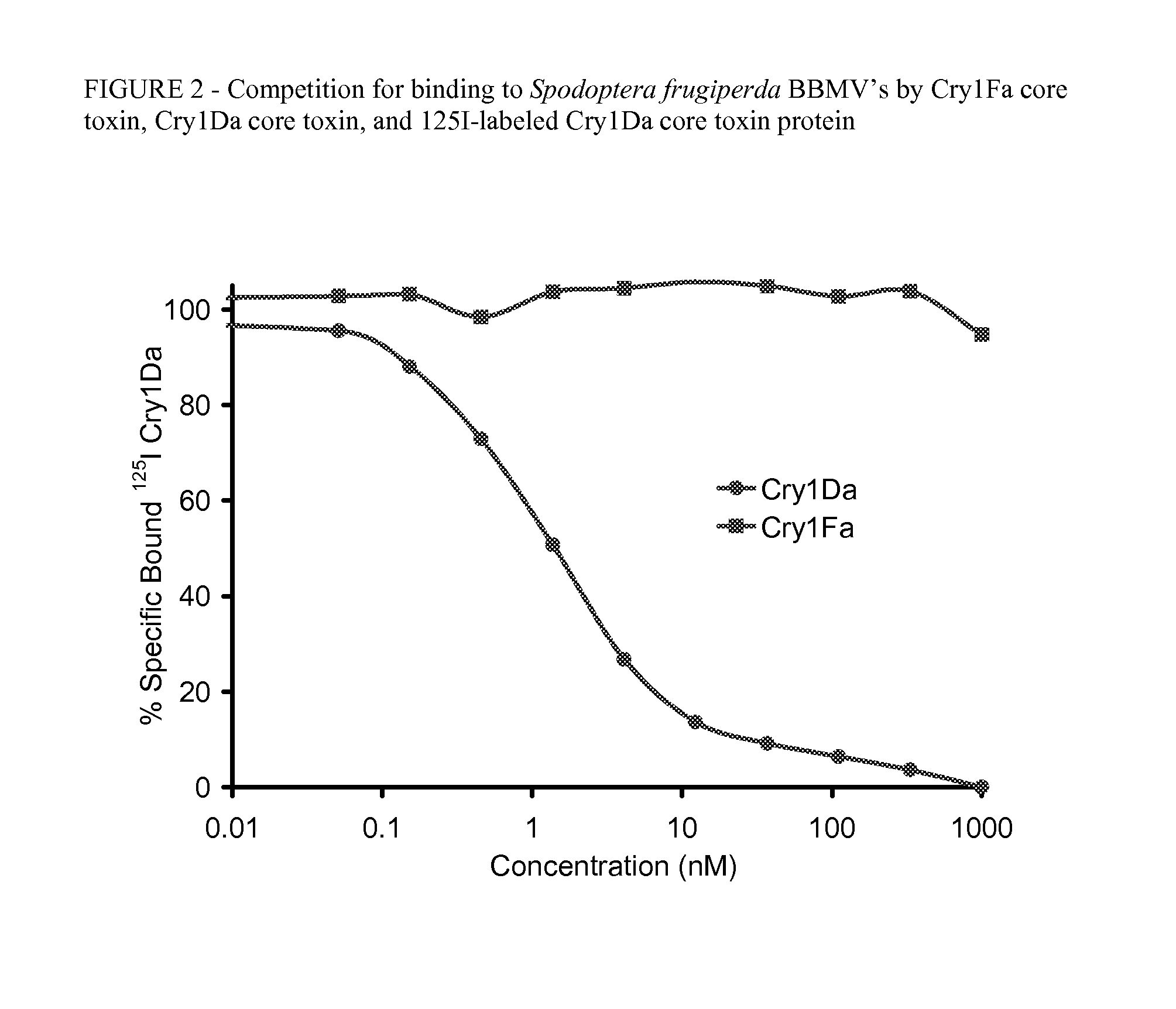COMBINED USE OF CRY1Da AND CRY1Fa PROTEINS FOR INSECT RESISTANCE MANAGEMENT
a technology of insect resistance and cry1fa, which is applied in the field of insect resistance management, can solve the problems of undermining human efforts, reducing the ability to conduct (competitive or homologous) receptor binding studies using cry1fa proteins, and additional billions lost to the damage they inflict, so as to reduce or eliminate the requirement for refuge acreage and reduce the selection pressure on other commercialized proteins
- Summary
- Abstract
- Description
- Claims
- Application Information
AI Technical Summary
Benefits of technology
Problems solved by technology
Method used
Image
Examples
example 1
Bioassay Data
[0100]Cry1Da expressed in transgenic corn (pDAS5163) provides protection from feeding by fall armyworm (FAW), Spodoptera frugiperda (J. E. Smith). The same events are more effective in controlling FAW that have developed resistance to Cry1Fa and are clearly superior to corn plants containing event TC1507, which is arguably the industry-leading insect resistance trait for FAW control.
[0101]We have also demonstrated that Cry1Fa (protein from recombinant Pseudomonas fluorescens strain DR1649; plasmid pDAB1817) and Cry1Da (protein from recombinant Pseudomonas fluorescens strain DC782) are both effective at controlling FAW in artificial diet bioassays and that the potency of the combination is greater than is expected from their individual potencies.
[0102]Based on the data described above, co-expressing Cry1Da and Cry1Fa can produce a high dose IRM stack for FAW, other important Spodoptera species, and perhaps other lepidopteran pests. Other proteins can be added to this com...
example 2
Summary of Binding Data
[0106]Competition binding experiments conducted with 125I-labeled Cry1Da using brush border membrane vesicles (BBMV) isolated from FAW are described below. The results from these experiments demonstrate that Cry1Da binds tightly to its receptor and that Cry1Fa does not compete with Cry1Da for binding sites. If resistance to Cry1Da could be based on a mutation to the receptor observed in these studies, these data suggest that Cry1Fa would be a good IRM tool for managing such resistant populations or mitigating the development of such resistance. Results from bioassays with Cry1Fa-resistant FAW (rFAW) demonstrate that Cry1Da is active on this population. Together, these data suggest that Cry1Fa and Cry1Da could be an IRM stack that effectively mitigates the development of resistance to either insecticidal protein.
[0107]Receptor binding assays show that 125I Cry1Da binds tightly to its receptor(s), and can be effectively competed off by unlabeled Cry1Da. Neither ...
example 3
Design of Chimeric Toxins Comprising Cry1 Core Toxins and Heterologous Protoxins
[0109]Chimeric Toxins.
[0110]Chimeric proteins utilizing the core toxin domain of one Cry toxin fused to the protoxin segment of another Cry toxin have previously been reported, for example, in U.S. Pat. No. 5,593,881 and U.S. Pat. No. 5,932,209.
[0111]Cry1Da chimeric protein variants of this invention include chimeric toxins comprising an N-terminal core toxin segment derived from a Cry1Da insecticidal toxin fused to a heterologous delta endotoxin protoxin segment at some point past the end of the core toxin segment. The transition from the core toxin to the heterologous protoxin segment can occur at approximately the native core toxin / protoxin junction or, in the alternative, a portion of the native protoxin (extending past the core toxin segment) can be retained, with the transition to the heterologous protoxin occurring downstream. In variant fashion, the core toxin and protoxin segments may comprise e...
PUM
| Property | Measurement | Unit |
|---|---|---|
| pH | aaaaa | aaaaa |
| pH | aaaaa | aaaaa |
| concentration | aaaaa | aaaaa |
Abstract
Description
Claims
Application Information
 Login to View More
Login to View More - R&D
- Intellectual Property
- Life Sciences
- Materials
- Tech Scout
- Unparalleled Data Quality
- Higher Quality Content
- 60% Fewer Hallucinations
Browse by: Latest US Patents, China's latest patents, Technical Efficacy Thesaurus, Application Domain, Technology Topic, Popular Technical Reports.
© 2025 PatSnap. All rights reserved.Legal|Privacy policy|Modern Slavery Act Transparency Statement|Sitemap|About US| Contact US: help@patsnap.com


